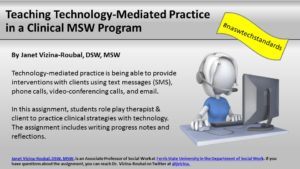Teaching Technology-Mediated Practice in a Clinical MSW Program
 Janet Vizina-Roubal, DSW, MSW, is an Associate Professor of Social Work at Ferris State University in the Department of Social Work. In this blog post, she writes about her inspiration for a technology-mediated practice assignment with MSW students. Assignments like this one will be increasingly valuable for social work students preparing to use technology with clients while meeting professional and ethical practice standards such as the NASW Code of Ethics and the NASW, ABSW, CSWE & ACSW Standards for Technology in Social Work Practice. If you have questions about the assignment, you can reach Dr. Vizina-Roubal on Twitter at @jvizina.
Janet Vizina-Roubal, DSW, MSW, is an Associate Professor of Social Work at Ferris State University in the Department of Social Work. In this blog post, she writes about her inspiration for a technology-mediated practice assignment with MSW students. Assignments like this one will be increasingly valuable for social work students preparing to use technology with clients while meeting professional and ethical practice standards such as the NASW Code of Ethics and the NASW, ABSW, CSWE & ACSW Standards for Technology in Social Work Practice. If you have questions about the assignment, you can reach Dr. Vizina-Roubal on Twitter at @jvizina.
I started teaching my first clinical MSW course the fall of 2014 with excitement and nervousness. With almost eight years of clinical experience in school social work and outpatient therapy, I had a great toolbox of practice tips to share with my students. Adding to the excitement was the idea of creating a technology-based assignment where students could learn and practice technology-enhanced therapy skills. Because I had completed and presented research with a colleague about the benefits of using iPhones in child welfare work, I was curious about how I could create a technology-based assignment for MSW social work students.
Clinical MSW social work classes typically rely on a vast amount of face-to-face role-plays, requiring students to play the part of client and social worker. This experiential learning is challenging, however is very effective at teaching students critical clinical skills. I was interested in stretching this experiential learning process into role-plays for a technology-mediated learning environment, with the goal of helping students learn how to engage with clients via technology-based communication tools. Based on this idea, I worked to structure assignments that would allow students to learn how to use technology within clinical social work. As I embarked on this journey, I searched for curricula or assignments on how to teach online therapy along with best practices. Bewildered, I found almost nothing (Cardenas, Serrano, Flores, & De 2008). I did stumble upon research that showed promising findings that online therapy might be as effective as face-to-face therapy (Chester & Glass, 2006; Dowling & Rickwood, 2013; Holmes & Foster, 2012). This finding legitimized my interest in pursuing this course of instruction and compelled me to develop assignments where students gained experience within online therapy; practicing as the client as well as the therapist.
 I referred to the assignments as “Technology-mediated Therapy Skills in Practice.” I defined technology-mediated practice as being able to provide interventions with clients using text messages (SMS), phone calls, video-conferencing calls, and email. . The assignments required students to set aside their traditional understanding of therapy and practice clinical strategies utilizing only text-based communication. The requirements of these assignments had multiple parts. Students had to be “the therapist” and “the client” using all four types of technology (texts, emails, etc.). For example, students were required to complete a progress note when they were the therapist for each of the four sessions. Finally, they had to write a reflection regarding their experience as the client and the therapist and their overall general feelings related to using technology-mediated practice.
I referred to the assignments as “Technology-mediated Therapy Skills in Practice.” I defined technology-mediated practice as being able to provide interventions with clients using text messages (SMS), phone calls, video-conferencing calls, and email. . The assignments required students to set aside their traditional understanding of therapy and practice clinical strategies utilizing only text-based communication. The requirements of these assignments had multiple parts. Students had to be “the therapist” and “the client” using all four types of technology (texts, emails, etc.). For example, students were required to complete a progress note when they were the therapist for each of the four sessions. Finally, they had to write a reflection regarding their experience as the client and the therapist and their overall general feelings related to using technology-mediated practice.
This type of assignment allows students to understand and practice the possible struggles with text-based communications, especially with regard to intense emotions that therapy sessions can bring up. Students can also experience technology-mediated therapy from the client perspective. This assignment has shown to provide students with great learning opportunities for students. Students have said that they learned how to communicate more effectively through text-based communication. They also stated that technology-mediated practice is not as difficult as they thought it would be. Students have said that they go through an “awakening” regarding using technology just by completing this one assignment.
However, what I had not originally foreseen was the intense resistance students would initially have to this type of practice. I discovered this resistance was generally related to their lack of comfort with therapy in general, and when I added the technology component, it added another layer of discomfort and uncertainty. To mitigate their resistance, I found that setting the backdrop for using technology-mediated therapy to be very beneficial. To introduce this assignment, I reviewed research to support its efficacy, and asked to students to watch a Ted Talk by Nancy Lublin regarding the positive benefits of crisis texting.
After students complete the assignment, I encourage them to share their initial perceptions as well as what they learned during these technology-mediated experiences in their reflections. I often get comments like “I am more confident in e-therapy skills” and “I had never thought I would like this type of practice but after doing this, I would consider it”. I also ensure students have the space and time to reflect and discuss their experiences during class time. I have also found it is important to allow students the opportunity to go beyond the clinical experience and discuss ethical and boundary implications as well as any other pertinent topics related to technology such as insurance companies not reimbursing for a text-based session and difficulty of getting a clinical master’s social work license in more than one state. Given the continued growth and infusion of technology in our lives, it indeed is important to provide social work students with not only basic exposure with technology-mediated therapy but with intense practice with technology throughout their social work education.
References:
Cárdenas, G., Serrano, B., Flores, L. A., & De, l. R. (2008). Etherapy: A training program for development of clinical skills in distance psychotherapy. Journal of Technology in Human Services, 26(2), 470-483. doi:10.1080/1522883080210180
Chester, A., & Glass C. (2006). Online counselling: A descriptive analysis of therapy services on the internet. British Journal of Guidance & Counselling, 34(2), 145-160. doi:10.1080/03069880600583170
Dowling, M., & Rickwood, D. (2013). Online counseling and therapy for mental health problems: A systematic review of individual synchronous interventions using chat. Journal of Technology in Human Services, 31(1), 1-21. doi:10.1080/15228835.2012.728508
Holmes, C., & Foster, V. (2012). A preliminary comparison study of online and face-to-face counseling: Client perceptions of three factors. Journal of Technology in Human Services, 30(1), 14-31. doi:10.1080/15228835.2012.662848
Lublin, N. (n.d.). How data from a crisis text line is saving lives. Retrieved from https://www.ted.com/talks/nancy_lublin_the_heartbreaking_text_that_inspired_a_crisis_help_line
National Association of Social Workers. (2008). Code of Ethics of the National Association of Social Workers. Retrieved from https://www.socialworkers.org/pubs/code/code.asp
National Association of Social Workers. (2017). NASW, ABSW, CSWE & ACSW Standards for Technology in Social Work Practice. Retrieved from http://www.socialworkers.org/includes/newIncludes/homepage/PRA-BRO-33617.TechStandards_FINAL_POSTING.pdf
How to Cite:
Vizina-Roubal, J. (2017, July 7). Teaching Technology-Mediated Practice in a Clinical MSW Program. Retrieved from: https://laureliversonhitchcock.org/2017/07/07/teaching-technology-mediated-practice-in-a-clinical-msw-program/


